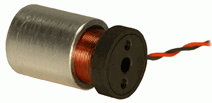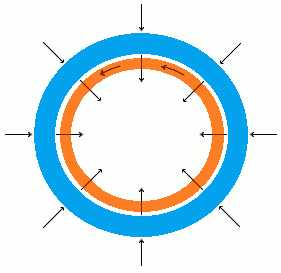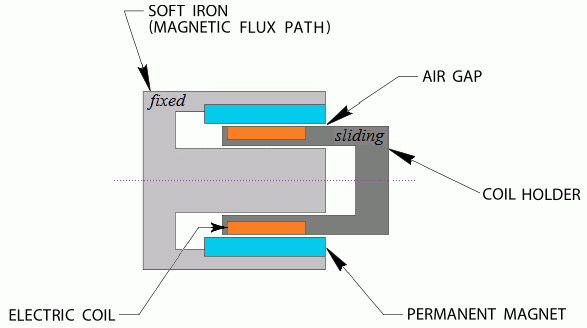

A voice coil is a kind of linear actuator, it moves a given mass along a line. To be precise, it pushes or pulls on the mass, the mass then moves as a result of this force. Thus a voice coil does not primarily move the mass, motion is a consequence of the force the voice coil applies to it.
The name “voice coil” is due to one of its historically first applications: vibrating the paper cone of a loudspeaker. The name stuck and voice coils designed to move larger masses at slower speeds in other applications are still called “voice coils.”
It is sometimes said that voice coils are intended for fast motion but they work just as well for slow motion. Again, a voice coil exerts a force, the consequence of that force depends on the circumstances.
The voice coil works because of the force between a magnetic field and an electric current perpendicular to the field, what is called the Lorentz force. Below is a schematic diagram of a current-carrying wire (orange) and a magnet (blue). Arrows indicate the direction of the electric current (right) and of the magnetic field (up):

If the magnet is fixed you can think of the magnet as pushing on the wire, and if the wire were free to move it would accelerate toward you all along its length.
If the magnetic field strength is constant, as with a permanent magnet, the magnitude of the force it exerts on the wire is proportional to the magnitude of the current through the wire.
Now imagine the magnet above as a rectangular slab extending into the page, and the single wire replaced by multiple wires repeated into the page. Bend both magnet and wires up and around until the left and right sides meet at the top forming one cylinder inside another. However, when the left and right ends of the wire segments meet, offset them so they form a single coil with only two wire ends. Voilà, the voice coil !

To help focus the magnetic field where it belongs the permanent magnet can be surrounded and held by “keeper” material – soft iron – capped at one end and penetrating the middle of the coil. It helps complete the magnetic circuit, in the course of which the field lines out of the North face become field lines into the South face. The coil is wrapped about a non-conducting cylinder capped at the other end. Below is a cross-section of the side view. The magnet pushes the coil (which in turn pushes the coil holder) to the right and left:

Voice coils have two advantages over other kinds of actuators:
Voice coils have some disadvantages, or at any rate different characteristics that must be taken into account, compared to other types of actuators. In those other types (stepper, DC) a motor is considerably geared down to move the working end of the actuator. Thus the motor can move the actuator end but because of gear friction the actuator end cannot move the motor. The actuator can maintain a force against the load while drawing no current. With a voice coil, a position that is intended to be fixed must be actively maintained against any force that would change it.
This must especially be taken into account with a vertically mounted voice coil. Current is required merely to counteract the static weight of the load. If that is a problem, the static weight can be counterbalanced by either springs or counterweights, like the window sash in some window mechanisms and the counterweights in elevators (lifts). Then the actuator need only draw current when accelerating the load.
Also the design must account for a sudden power outage, that is, it must fail safely when the actuator force summarily drops to zero.
Another possible complication is that when the coil moves rapidly the magnet induces a current in it opposing the current due to the driving voltage – a “back EMF.” However this is negligible when the operation is slow. The inductance of the coil, which introduces a time lag between applied voltage and current, is negligible when the movement changes slowly.
Several numbers describe a particular voice coil. Here are the most important ones.
Mechanical parameters:
Voice coils come in two shapes: cylindrical (circular as viewed along the axis) just described, and rectangular (as viewed along the axis). Another variation is to bend the voice coil sideways into an arc, like a macaroni noodle (in that case the actuator is no longer linear).
Bearings can be added between the coil and magnet/keeper so that they maintain alignment and don’t touch one another. Such voice coils are called “housed.” Voice coils are also made without bearings and called “unhoused.”
The alignment for unhoused voice coils is provided by the particular application. The magnet part and electric part are rigidly attached to two other parts of the assembly (one fixed, the other movable) which are themselves aligned and consequently keep the voice coil aligned. This is useful for not over-determining the assembly (having to align two alignments).
Publications available online: